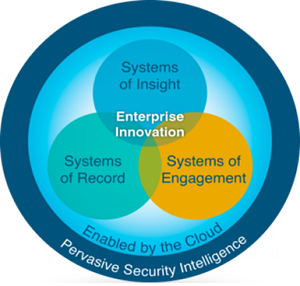
Cloud, mobile and social engagement are driving a digital disruption that’s revolutionizing business. Individuals are more connected than ever before, taking advantage of more diverse channels of engagement. Readily available digital technologies have empowered consumers to expect more from their service providers (financial institutions, government, retailers and so on). They want faster, more transparent ways of doing business as well as new services. Traditional boundaries are shifting, and new competitors—enabled by digital technologies—are entering new industries and challenging the established players.
A recent worldwide CxO survey conducted by the IBM Institute for Business Value shows that CxOs expect “industry convergence” to have the biggest impact on business in the next three to five years. New permutations are emerging out of “old” industries, like the marriage of consumer electronics and healthcare with the digital exercise tracker Fitbit, or the agrochemical giant Monsanto’s transformation into an IT firm as it develops real-time tools to help farmers maximize crop yields.
Boundaries between industries are eroding, and whole business models and operations are being transformed as organizations redefine their value proposition and client engagement. Technology factors, including integration across digital and physical assets, as well as concerns around financial risks, data security and regulatory compliance are top of mind for many businesses and IT organizations.
Succeeding in this new economy requires organizations to embark on a transformative digital journey to unlock innovation across the enterprise. A foundational element of this transformation is the integration of new technologies with existing core systems into hybrid clouds.

Why hybrid cloud?
The National Institute of Standards and Technology defines hybrid cloud as a “composition of two or more distinct cloud infrastructures (private, community, or public) that remain unique entities, but are bound together by standardized or proprietary technology that enables data and application portability (e.g., cloud bursting for load balancing between clouds).” Here it’s important to recognize that most IT organizations also have substantial investments in traditional “on-premises” IT infrastructure, and we know from experience that not all workloads running on this infrastructure are a good fit for cloud.
 Traditional core systems such as accounting applications and key production systems that record internal proprietary data are called “systems of record,” and many of them will continue to stay on premises, running on the existing infrastructure and/or a private cloud. At the other end of the spectrum are “systems of engagement” like mobile and social applications, typically highly agile, requiring an elastic infrastructure (that is, public and/or private cloud) and focused on transforming the relationships with users (for example, customers, employees and so forth). The wealth of information generated by these systems of engagement should be harnessed to produce valuable insights.
Traditional core systems such as accounting applications and key production systems that record internal proprietary data are called “systems of record,” and many of them will continue to stay on premises, running on the existing infrastructure and/or a private cloud. At the other end of the spectrum are “systems of engagement” like mobile and social applications, typically highly agile, requiring an elastic infrastructure (that is, public and/or private cloud) and focused on transforming the relationships with users (for example, customers, employees and so forth). The wealth of information generated by these systems of engagement should be harnessed to produce valuable insights.
Advanced analytics and cognitive computing systems are able harness big data into “systems of insight” for competitive advantage. To enable innovation, IT organizations will need to take a holistic approach to building, deploying and integrating systems of engagement, systems of insight and systems of record. Hybrid cloud represents the next-generation infrastructure on which these systems and the corresponding services can be deployed, offering the agility, speed to market and operational efficiency the business is looking for.
Planning your hybrid cloud is critical
A successful adoption of hybrid cloud requires thoughtful planning and a clear strategy. While most IT organizations understand the value of building an enterprise-wide cloud strategy, they face several challenges:
- A lack of skilled resources
- Internal politics
- Technical biases
- Limited time
- Limited budgets
IBM Lab Services Systems Consulting, in collaboration with other IBM teams, has developed an adaptable method to help organizations accelerate adoption of hybrid cloud, maximizing the value of their existing investments and setting the foundation for improved business outcomes.
As you take the next step on your hybrid cloud journey, it can be helpful to partner with IT professionals who have experience helping a wide range of companies to plan and implement hybrid cloud projects. In IBM Systems Lab Services, empowering organizations with cloud computing is central to our work, and that extends all the way from planning to execution. We use a consultative approach leveraging our proven experience in IT infrastructure and hybrid cloud technologies to help identify each client’s optimal path to hybrid cloud.
Written by: John Karaba


















